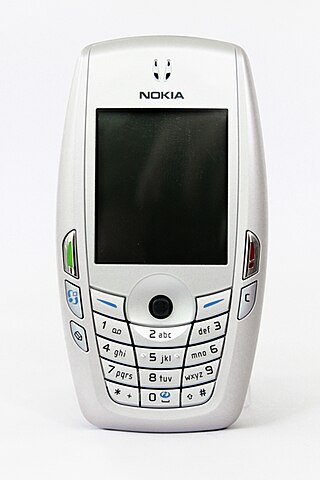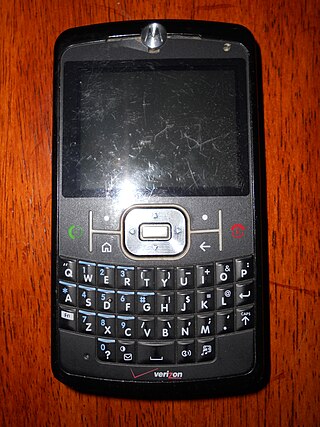
General Packet Radio Service (GPRS), also called 2.5G, is a mobile data standard on the 2G cellular communication network's global system for mobile communications (GSM). Networks and mobile devices with GPRS started to roll out around the year 2001. At the time of introduction it offered for the first time seamless mobile data transmission using packet data for an "always-on" connection, providing improved Internet access for web, email, WAP services, and Multimedia Messaging Service (MMS).

A personal digital assistant (PDA) is a multi-purpose mobile device which functions as a personal information manager. Following a boom in the 1990's and 2000's, PDA's were mostly displaced by the widespread adoption of more highly capable smartphones, in particular those based on iOS and Android in the late 2000's, and thus saw a rapid decline.

The 6620 is a mobile phone created by Nokia, announced in 2005, running on Series 60 2nd Edition and the Symbian operating system. It was the first EDGE-capable phone for the Americas' market.
The Motorola MPx200 smartphone was launched in December 2003 as a joint venture between Motorola and Microsoft. The mobile phone's Windows Mobile for Smartphone OS allows users to access email and the Internet, use MSN Messenger, and view documents in Microsoft Office formats much like other Windows smartphones such as the Samsung SGH-i600 or HTC Tanager. The MPx200, along with the Samsung SCH-i600, were the first Windows Mobile smartphone devices to have wide distribution in the United States. Previously, smartphone platform devices could only be purchased in the United States as part of development kits sold by Microsoft. The only U.S. carrier of the phone was AT&T Wireless; however, reports also suggest a somewhat limited number of devices with Cingular branding have appeared following the purchase of AT&T Wireless by Cingular.

The Sony Ericsson T610, released in 2003, is a mobile phone manufactured by Sony Ericsson. It was one of the first widely available mobile phones to include a built-in digital camera, Bluetooth, color screen, joystick navigation, and was a very high selling model. The T630 was a later variant.
The O2 Xda brand was a range of Windows Mobile PDA phones, marketed by O2, developed by O2 Asia and manufactured by multiple OEMs (mainly HTC, Quanta and Arima). The first model was released in June 2002. The last models came to market in 2008. The "X" represents convergence of voice and information/data within one product; the "DA" stands for "Digital Assistant", as in PDA. The name of XDA Developers is derived from it.

A mobile phone feature is a capability, service, or application that a mobile phone offers to its users. Mobile phones are often referred to as feature phones, and offer basic telephony. Handsets with more advanced computing ability through the use of native code try to differentiate their own products by implementing additional functions to make them more attractive to consumers. This has led to great innovation in mobile phone development over the past 20 years.
The Motorola ROKR, the first version of which was informally known as the iTunes phone, was a series of mobile phones from Motorola, part of a 4LTR line developed before the spin out of Motorola Mobility. ROKR models were released starting in September 2005 and ending in 2009. They were notable for incorporating support of media player features.

The Sony Ericsson K800i, and its variant, the Sony Ericsson K790, are mobile phone handsets manufactured by Sony Ericsson. Launched in July 2006, the phones are the successor to the Sony Ericsson K750i, and are the first to be tagged with the Sony Cyber-shot branding. Both of the phones feature a 3.2-megapixel digital camera complete with a xenon flash, a protective lens cover, and a new "BestPic" bracketing feature. The new "BestPic" feature takes 9 full quality snapshots of a subject in quick succession, allowing the user to choose the best shots from them. On the entertainment front, the phones have a media player supporting MP3, AAC/AAC+/eAAC+ and WMA music files and 3GP/MPEG-4 video files. The phones also feature a RDS FM radio, and a Memory Stick Micro (M2) slot for expandable solid state memory. The K790/K800 models are also the first Sony Ericsson mobile phones to use ATI's Imageon 2192 graphics engine, which delivers a full 3D gaming graphics for Java and full support for its 3.2-megapixel camera. It is the phone used by James Bond in the 2006 Casino Royale film and trailers.

The HTC TyTN is an Internet-enabled Windows Mobile Pocket PC PDA designed and marketed by High Tech Computer Corporation of Taiwan. It has a touchscreen with a left-side slide-out QWERTY keyboard. The TyTN's functions include those of a camera phone and a portable media player in addition to text messaging and multimedia messaging. It also offers Internet services such as e-mail, instant messaging, web browsing, and local Wi-Fi connectivity. It is a quad-band GSM phone with GPRS, and EDGE, and a single/dual band UMTS phone with HSDPA. It is a part of the first line of PDAs directly marketed and sold by HTC. On AT&T/Cingular, the TyTN was the successor to the HTC Wizard, known as the Cingular 8125. Also on AT&T, the TyTN was superseded by the HTC TyTN II, known as the AT&T 8925 and the AT&T Tilt.

The Palm Treo 680 is a combination hybrid PDA/cellphone, or smartphone as the successor to the company's Treo 650.

The HTC TyTN II is an Internet-enabled Windows Mobile Pocket PC smartphone designed and marketed by HTC Corporation of Taiwan. It has a tilting touchscreen with a right-side slide-out QWERTY keyboard. The TyTN II's functions include those of a camera phone and a portable media player in addition to text messaging and multimedia messaging. It also offers Internet services including e-mail, instant messaging, web browsing, and local Wi-Fi connectivity. It is a quad-band GSM phone with GPRS, EDGE, UMTS, HSDPA, and HSUPA.

The HTC P4350 is a Pocket PC smartphone manufactured by High Tech Computer Corporation (HTC) of Taiwan. It is also known as the HTC Herald, T-Mobile Wing, and XDA Terra. An updated model running Windows Mobile 6, the HTC P4351, has been sold as the HTC Atlas. It features a right-side QWERTY slide and runs the Windows Mobile 6.0/6.1 Professional Edition operating system.
COM One group was a manufacturer best known for its computer network adapters. The company was co-founded in 1987 by Jacques Saubade and Michel Petit and was headquartered in France. The name comes from the company's focus on modems.

Nokia 5300 XpressMusic is a slider mobile phone by Nokia, part of the XpressMusic range. It was introduced on 26 September 2006 and released at the end of that year. It runs on Nokia Series 40 3rd Edition FP2.

The Motorola Q9c was a smartphone first released in 2007. Initially released as an upgrade to Motorola's Q Series, the Q9C contained a Windows Mobile 6 operating system, push email and instant messaging capabilities, a 1.3 megapixel camera, stereo sound, as well as Bluetooth and GPS navigation.

The Xperia X1 is a high-end smartphone from Sony Ericsson, and is the first in the manufacturer's Xperia series. The phone was designed and built by Taiwanese OEM HTC. The X1 was first presented at the 2008 Mobile World Congress.

The Sony Ericsson W350 is a mobile phone that belongs to the Walkman series. It is available in three versions: W350i, W350a and W350c.

The BlackBerry Tour is a consumer smartphone developed by BlackBerry Limited and is part of the 9600 device series. This high-end messaging phone combines the multimedia features of the Curve with the global roaming of the 8830, plus a higher-resolution display, 3.2 megapixel auto-focus camera, overseas 3G data and faster EVDO Rev. A data in the United States and Canada. Other key features include voice calling, video capture, a 3.5mm audio jack, a microSD slot, push email, a QWERTY keyboard, Bluetooth, and GPS navigation. The BlackBerry Tour was released on July 12, 2009. In 2010, the 'Tour 2' refresh was re-branded as the Blackberry Bold 9650 when RIM decided to merge the GSM and CDMA2000 variants under the same brand.
The LG Incite is an Internet-enabled Windows Mobile Pocket PC smartphone designed and marketed by LG of Korea.















